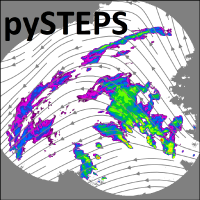pysteps.extrapolation.semilagrangian.extrapolate#
- pysteps.extrapolation.semilagrangian.extrapolate(precip, velocity, timesteps, outval=nan, xy_coords=None, allow_nonfinite_values=False, vel_timestep=1, **kwargs)#
Apply semi-Lagrangian backward extrapolation to a two-dimensional precipitation field.
- Parameters:
precip (array-like or None) – Array of shape (m,n) containing the input precipitation field. All values are required to be finite by default. If set to None, only the displacement field is returned without interpolating the inputs. This requires that return_displacement is set to True.
velocity (array-like) – Array of shape (2,m,n) containing the x- and y-components of the m*n advection field. All values are required to be finite by default.
timesteps (int or list of floats) – If timesteps is integer, it specifies the number of time steps to extrapolate. If a list is given, each element is the desired extrapolation time step from the current time. The elements of the list are required to be in ascending order.
outval (float, optional) – Optional argument for specifying the value for pixels advected from outside the domain. If outval is set to ‘min’, the value is taken as the minimum value of precip. Default: np.nan
xy_coords (ndarray, optional) –
Array with the coordinates of the grid dimension (2, m, n ).
xy_coords[0]: x coordinates
xy_coords[1]: y coordinates
By default, the xy_coords are computed for each extrapolation.
allow_nonfinite_values (bool, optional) – If True, allow non-finite values in the precipitation and advection fields. This option is useful if the input fields contain a radar mask (i.e. pixels with no observations are set to nan).
displacement_prev (array-like) – Optional initial displacement vector field of shape (2,m,n) for the extrapolation. Default: None
n_iter (int) – Number of inner iterations in the semi-Lagrangian scheme. If n_iter > 0, the integration is done using the midpoint rule. Otherwise, the advection vectors are taken from the starting point of each interval. Default: 1
return_displacement (bool) – If True, return the displacement between the initial input field and the one obtained by integrating along the advection field. Default: False
vel_timestep (float) – The time step of the velocity field. It is assumed to have the same unit as the timesteps argument. Applicable if timesteps is a list. Default: 1.
interp_order (int) – The order of interpolation to use. Default: 1 (linear). Setting this to 0 (nearest neighbor) gives the best computational performance but may produce visible artefacts. Setting this to 3 (cubic) gives the best ability to reproduce small-scale variability but may significantly increase the computation time.
- Returns:
out – If return_displacement=False, return a time series extrapolated fields of shape (num_timesteps,m,n). Otherwise, return a tuple containing the extrapolated fields and the integrated trajectory (displacement) along the advection field.
- Return type:
array or tuple
References
[GZ02]
